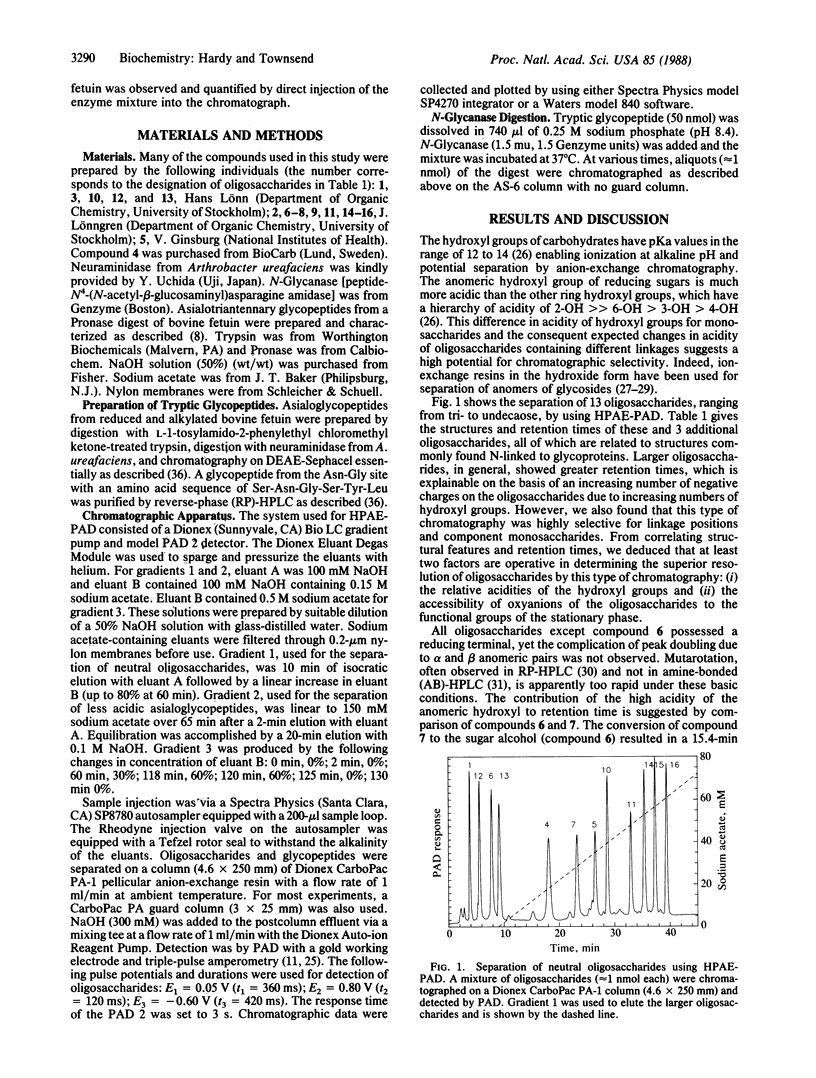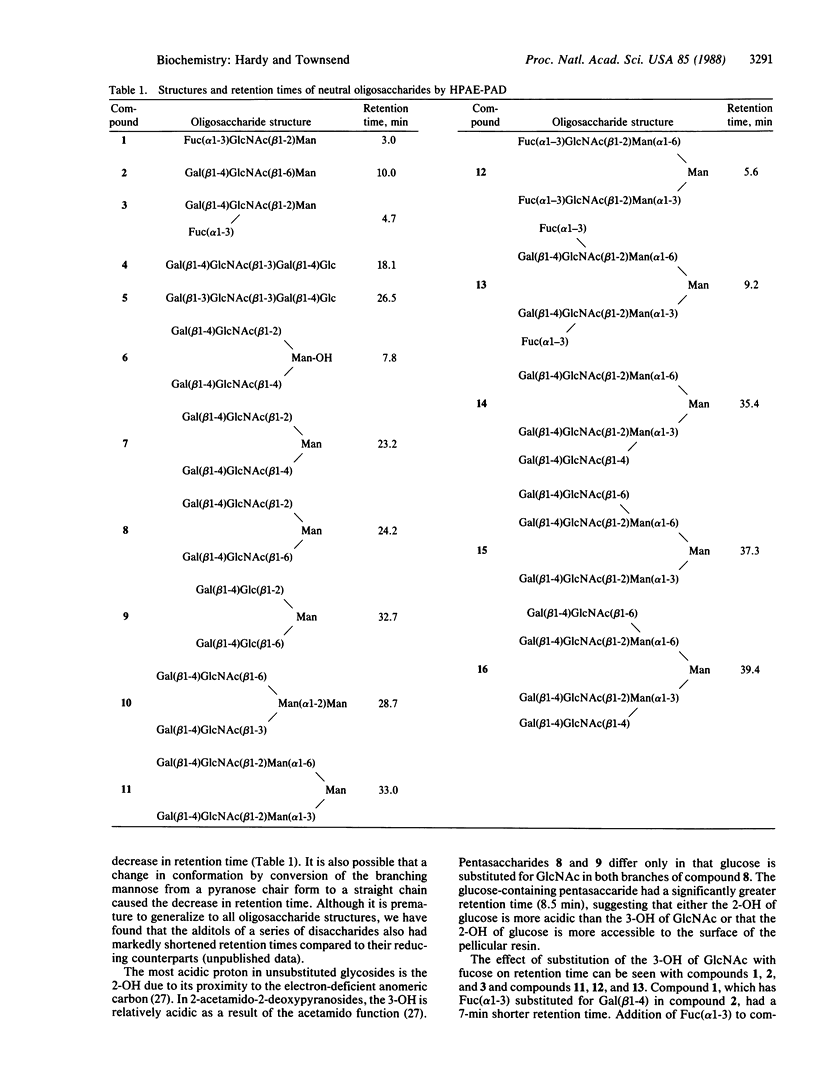Abstract
High-performance anion-exchange (HPAE) chromatography under alkaline conditions (pH congruent to 13) has been found to efficiently separate neutral oligosaccharides (triose to undecaose) according to molecular size, sugar composition, and linkage of monosaccharide units. The method was able to resolve 1----3, 1----4, and 1----6 positional isomers of neutral oligosaccharides, which are defined as having the same number, type, sequence, and anomeric configurations of monosaccharides but differing in the linkage position of a single sugar. From correlating structural features of different oligosaccharides and retention times, we deduced that at least two factors are operative to determine the superior resolution of oligosaccharides by this type of chromatography: (i) the relative acidities of the hydroxyl groups and (ii) the accessibility of oxyanions of the oligosaccharides to the functional groups of the stationary phase. Splitting of peaks attributable to mutarotation was not observed. Reducing oligosaccharides were much more retained than their reduced counterparts. Linkage of Fuc(alpha 1-3) to GlcNAc of oligosaccharides markedly decreased retention times. Positional isomers of two branched monosaccharides, which differed by 1----6 and 1----4 linkages, were widely separated. The separation of 1----3 and 1----4 positional isomers of both tetrasaccharides and glycopeptides containing undecasaccharides demonstrated the significant improvement in resolution of HPAE compared to previous chromatographic methods by either reverse-phase or amine-bonded stationary phases. Picomole quantities of underivatized oligosaccharides have been detected by triple-pulse amperometric detection, which produced similar responses for a wide range of structures. Quantification of two triantennary glycopeptides from bovine fetuin by using either detector response or 1H NMR was comparable. The N-glycanase-catalyzed release of two 1----4 and 1----3 positional isomers of an undecasaccharide from a tryptic glycopeptide of bovine fetuin could be observed and quantified by direct injection of the enzyme mixture into the chromatograph.
Full text
PDF




Selected References
These references are in PubMed. This may not be the complete list of references from this article.
- Abe K., McKibbin J. M., Hakomori S. The monoclonal antibody directed to difucosylated type 2 chain (Fuc alpha 1 leads to 2Gal beta 1 leads to 4[Fuc alpha 1 leads to 3]GlcNAc; Y Determinant). J Biol Chem. 1983 Oct 10;258(19):11793–11797. [PubMed] [Google Scholar]
- Blanken W. M., Bergh M. L., Koppen P. L., van den Eijnden D. H. High-pressure liquid chromatography of neutral oligosaccharides: effects of structural parameters. Anal Biochem. 1985 Mar;145(2):322–330. doi: 10.1016/0003-2697(85)90369-0. [DOI] [PubMed] [Google Scholar]
- Blanken W. M., Hooghwinkel G. J., Van Den Eijnden D. H. Biosynthesis of blood-group I and i substances. Specificity of bovine colostrum beta-N-acetyl-D-glucosaminide beta 1 leads to 4 galactosyltransferase. Eur J Biochem. 1982 Oct;127(3):547–552. [PubMed] [Google Scholar]
- Blumberg K., Liniere F., Pustilnik L., Bush C. A. Fractionation of oligosaccharides containing N-acetyl amino sugars by reverse-phase high-pressure liquid chromatography. Anal Biochem. 1982 Jan 15;119(2):407–412. doi: 10.1016/0003-2697(82)90605-4. [DOI] [PubMed] [Google Scholar]
- Dekker C. A. Separation of nucleoside mixtures on Dowex-1 (OH-). J Am Chem Soc. 1965 Sep 5;87(17):4027–4029. doi: 10.1021/ja01095a073. [DOI] [PubMed] [Google Scholar]
- Dennis J. W., Laferté S. Recognition of asparagine-linked oligosaccharides on murine tumor cells by natural killer cells. Cancer Res. 1985 Dec;45(12 Pt 1):6034–6040. [PubMed] [Google Scholar]
- Dua V. K., Bush C. A. Resolution of some glycopeptides of hen ovalbumin by reverse-phase high-pressure liquid chromatography. Anal Biochem. 1984 Feb;137(1):33–40. doi: 10.1016/0003-2697(84)90342-7. [DOI] [PubMed] [Google Scholar]
- Green E. D., Baenziger J. U. Oligosaccharide specificities of Phaseolus vulgaris leukoagglutinating and erythroagglutinating phytohemagglutinins. Interactions with N-glycanase-released oligosaccharides. J Biol Chem. 1987 Sep 5;262(25):12018–12029. [PubMed] [Google Scholar]
- Honda S. High-performance liquid chromatography of mono- and oligosaccharides. Anal Biochem. 1984 Jul;140(1):1–47. doi: 10.1016/0003-2697(84)90130-1. [DOI] [PubMed] [Google Scholar]
- Mellis S. J., Baenziger J. U. Size fractionation of anionic oligosaccharides and glycopeptides by high-performance liquid chromatography. Anal Biochem. 1983 Oct 15;134(2):442–449. doi: 10.1016/0003-2697(83)90320-2. [DOI] [PubMed] [Google Scholar]
- Paulson J. C., Weinstein J., de Souza-e-Silva U. Biosynthesis of a disialylated sequence in N-linked oligosaccharides: identification of an N-acetylglucosaminide (alpha 2----6)-sialyltransferase in Golgi apparatus from rat liver. Eur J Biochem. 1984 May 2;140(3):523–530. doi: 10.1111/j.1432-1033.1984.tb08133.x. [DOI] [PubMed] [Google Scholar]
- Plummer T. H., Jr, Elder J. H., Alexander S., Phelan A. W., Tarentino A. L. Demonstration of peptide:N-glycosidase F activity in endo-beta-N-acetylglucosaminidase F preparations. J Biol Chem. 1984 Sep 10;259(17):10700–10704. [PubMed] [Google Scholar]
- Rao B. N., Dua V. K., Bush C. A. Conformations of blood group H-active oligosaccharides of ovarian cyst mucins. Biopolymers. 1985 Dec;24(12):2207–2229. doi: 10.1002/bip.360241205. [DOI] [PubMed] [Google Scholar]
- Ronin C., Papandreou M. J., Canonne C., Weintraub B. D. Carbohydrate chains of human thyrotropin are differentially susceptible to endoglycosidase removal on combined and free polypeptide subunits. Biochemistry. 1987 Sep 8;26(18):5848–5853. doi: 10.1021/bi00392a040. [DOI] [PubMed] [Google Scholar]
- Sasaki H., Bothner B., Dell A., Fukuda M. Carbohydrate structure of erythropoietin expressed in Chinese hamster ovary cells by a human erythropoietin cDNA. J Biol Chem. 1987 Sep 5;262(25):12059–12076. [PubMed] [Google Scholar]
- Takasaki S., Mizuochi T., Kobata A. Hydrazinolysis of asparagine-linked sugar chains to produce free oligosaccharides. Methods Enzymol. 1982;83:263–268. doi: 10.1016/0076-6879(82)83019-x. [DOI] [PubMed] [Google Scholar]
- Tomiya N., Kurono M., Ishihara H., Tejima S., Endo S., Arata Y., Takahashi N. Structural analysis of N-linked oligosaccharides by a combination of glycopeptidase, exoglycosidases, and high-performance liquid chromatography. Anal Biochem. 1987 Jun;163(2):489–499. doi: 10.1016/0003-2697(87)90253-3. [DOI] [PubMed] [Google Scholar]
- Townsend R. R., Hardy M. R., Wong T. C., Lee Y. C. Binding of N-linked bovine fetuin glycopeptides to isolated rabbit hepatocytes: Gal/GalNAc hepatic lectin discrimination between Gal beta(1,4)GlcNAc and Gal beta(1,3)GlcNAc in a triantennary structure. Biochemistry. 1986 Sep 23;25(19):5716–5725. doi: 10.1021/bi00367a055. [DOI] [PubMed] [Google Scholar]
- Wang W. T., LeDonne N. C., Jr, Ackerman B., Sweeley C. C. Structural characterization of oligosaccharides by high-performance liquid chromatography, fast-atom bombardment-mass spectrometry, and exoglycosidase digestion. Anal Biochem. 1984 Sep;141(2):366–381. doi: 10.1016/0003-2697(84)90057-5. [DOI] [PubMed] [Google Scholar]
- Wood E., Lecomte J., Childs R. A., Feizi T. A radioimmunoassay for the measurement of blood group Ii activities: its application to glycoconjugates, oligosaccharides and intact cells. Mol Immunol. 1979 Oct;16(10):813–819. doi: 10.1016/0161-5890(79)90160-3. [DOI] [PubMed] [Google Scholar]


